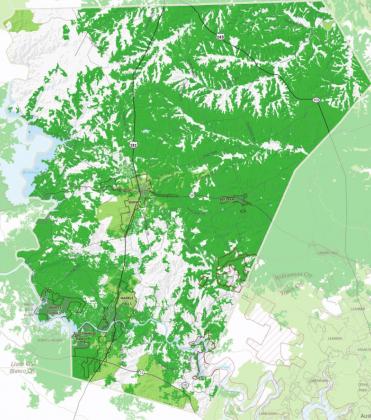Updated broadband coverage maps show 89.74 percent of households in Burnet County have the minimum requirements for high-speed internet available to them, Connected Nation Texas (CN Texas) reported this week.
Llano County is just behind Burnet County with 87.27 percent of households receiving broadband service with speeds of at least 25 Megabytes per second download and three Mbps upload — which is the minimum classification recognized by the Federal Communications Commission (FCC).
However, this still leaves 1,694 homes in Burnet County and 1,147 homes in Llano County without the minimum recommended internet connection necessary to take part in the fast-changing digital landscape.
And both amounts are still below the statewide rural and overall averages, which are 90.3 percent and 96.5 percent, respectively.
Those numbers grow even more stark when determining how many homes actually receive broadband service with speeds of at least 100 Mbps download and 10 Mbps upload. In Burnet County, just 41.84 percent of all households can receive that level of service (leaving 9,602 underserved households).
This includes all of Granite Shoals, Highland Haven, Cottonwood Shores and Kingsland and rural areas like Oakalla, Briggs, Hoover Valley, Cassie, East Lake Buchanan, Smithwick and parts of Spicewood.
In Llano County, that percentage falls to 30.2 percent (with 6,288 underserved households). This includes most of Horseshoe Bay and all of Kingsland, Sunrise Beach, Sandy Harbor, Click and Castell.
The overall statewide average for 100x10 internet is 88.6 percent of households in a service area, while the overall rural area average is still more than two-thirds at 68.9 percent of households.
Earlier this year, Burnet and Llano counties were among the entities which joined forces with Connected Nation Texas, an independent, public and private initiative working to ensure that all can experience the benefits of broadband in the state, in order to try to better leverage available resources to improve local internet service.
CN Texas just published updated broadband coverage maps for all 254 counties in the state, with the latest being the third update, which provided new observations and insights.
“We must continue to improve and refine the data on these broadband coverage maps,” said Jennifer Harris, state program director, CN Texas. “That way we can get a more complete picture of the broadband landscape across Texas — specifically identifying more accurately where households and even whole communities lack high-speed internet access.
“This information and data can then help inform decisions at both the state and community level, ensuring that more effective and intelligent investments are made to connect those areas with the need.”
CN Texas released the initial maps in January of 2020 and updated maps in late July. Each new set of maps includes additional input from residents, businesses and communities, as well as new, more granular data from internet service providers (ISPs).
“We will be providing, in total, five mapping updates for Texas, which is a robust and aggressive approach to tackling the issue of connectivity in the state,” said Ashley Hitt, Vice President, GIS Services, Connected Nation.
“Each iteration is improved by public feedback, working with providers to refine their data, and continued field validation so that the data truly reflects what broadband coverage looks like across Texas.”
The Federal Communications Commission (FCC) classifies high-speed internet speeds at 25 Mbps download/3 Mbps upload (listed below as 25x3). Some key findings from the new data include:
• Over 315,000 Texas households remain unserved at 25x3 speeds.
• Twenty-eight counties have less than half of their households served by 25x3 broadband.
“To close the Digital Divide in Texas, we need accurate data on where Texans are connected and where they lack basic infrastructure to participate in the digital world,” said Ellen Ray, chair, Texas Rural Funders and executive director, Still Water Foundation.
“The future of Texas education, healthcare, and economic development will depend on all Texans having the ability to access high-speed internet. Texas Rural Funders is proud to support Connected Nation Texas in providing critical broadband data for community planning and legislative decision making.”
To learn more about CN Texas, email Jennifer Harris at jharris@connectednation. org or visit the CN Texas website at connectednation.org/ texas.



